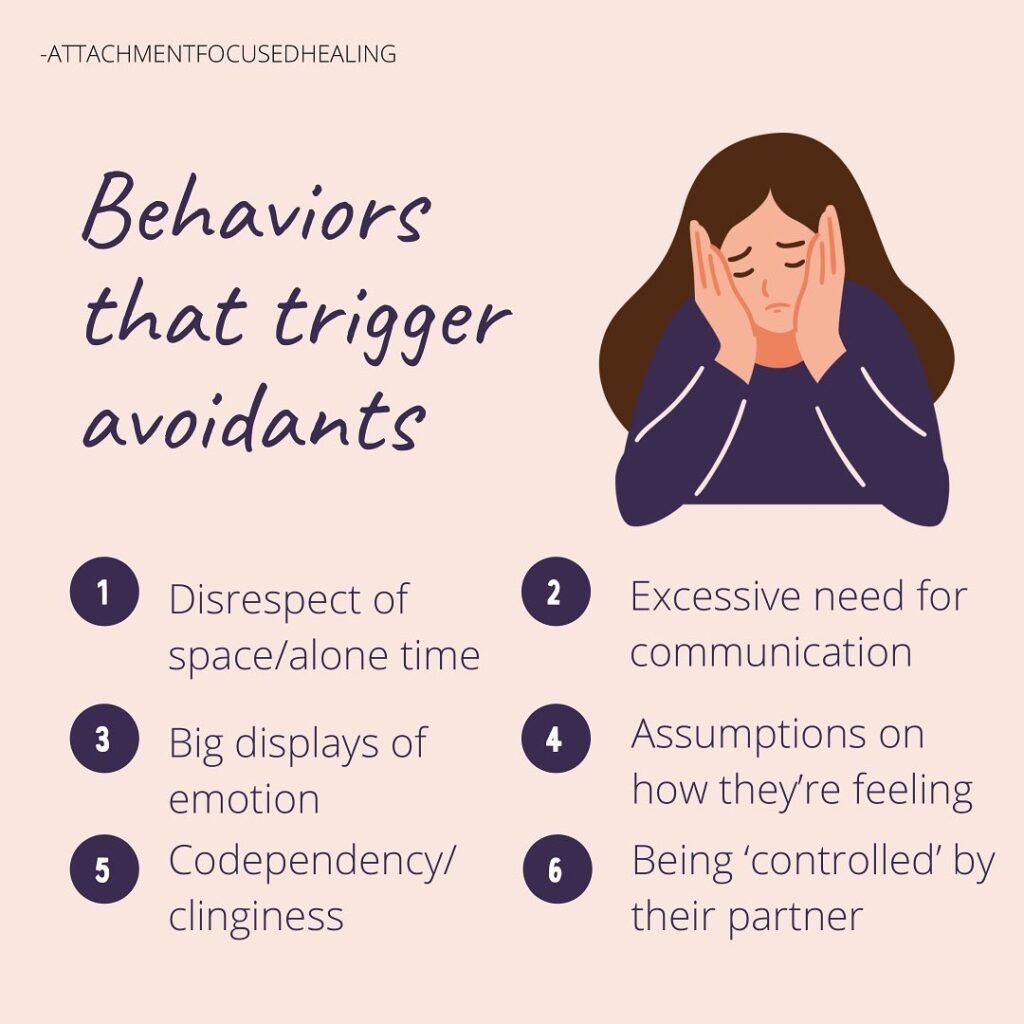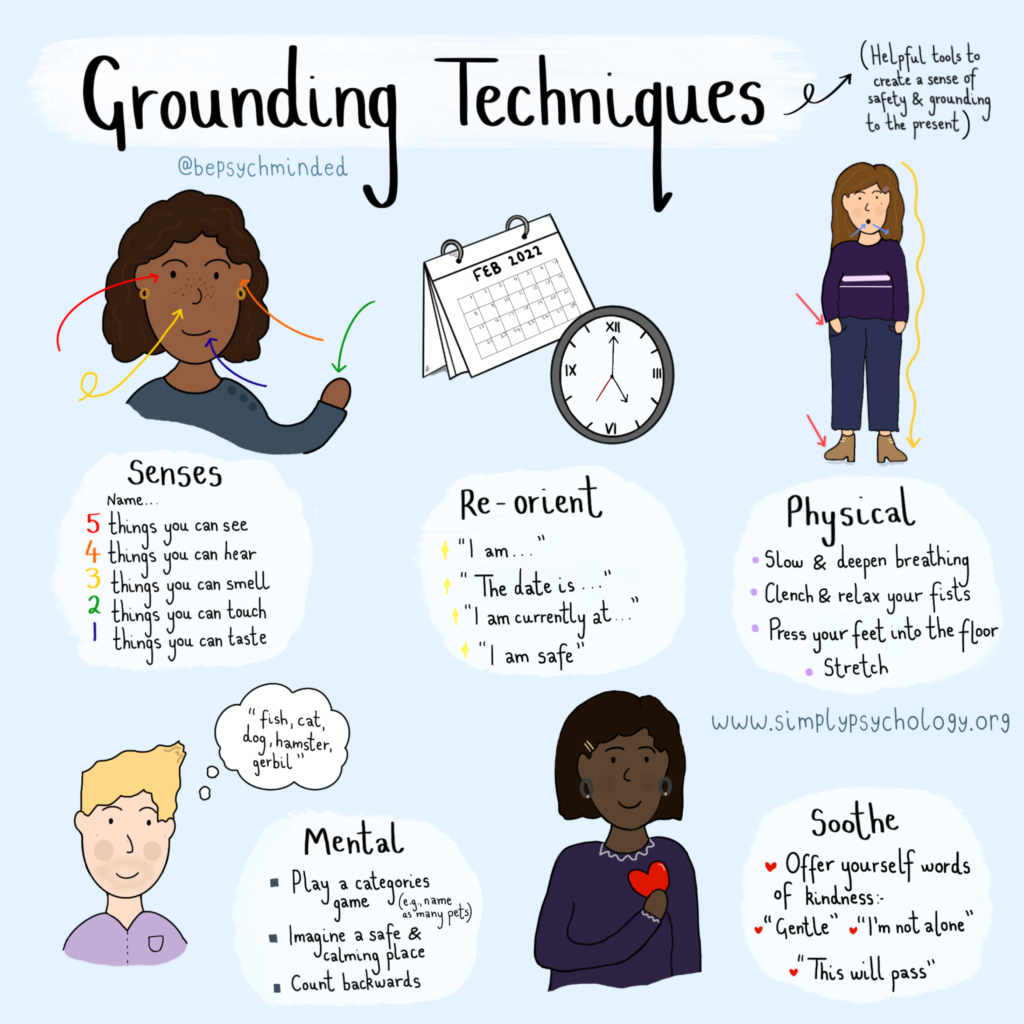On This Page:
The Dismissive Avoidant Attachment style is one of the four main attachment styles proposed by attachment theory, which describes the ways individuals form and maintain emotional bonds with others.
People with a dismissive avoidant attachment style typically exhibit a tendency to emotionally distance themselves from others, particularly in close relationships. These individuals often deny the importance of closeness and intimacy, maintain high self-reliance, and disregard or suppress emotional connections due to their defensive dismissal of attachment needs.
The dismissive avoidant attachment style describes a way of relating to other people that is distant, self-reliant, and distrusting.

Individuals with a dismissive avoidant attachment style often value their independence and autonomy above emotional intimacy and connection.
This is often because these individuals were emotionally deprived in childhood and grew up with parents who did not provide enough emotional support and warmth.
Many individuals with a dismissive avoidant attachment style do not consciously experience emotional distance, though. They tend to have busy social lives filled with friends and sexual partners and are often even perceived as confident and content.
But their relationships, social lives, and emotional involvements tend to be shallow — Beneath the self-assured surface lies vulnerability and the belief that they are unworthy of love.
Therefore, it’s important to work towards healing attachment insecurities in order to build and maintain secure and fulfilling relationships.
Fortunately, attachment styles are not fixed or permanent traits. They can evolve and change over time, influenced by one’s own self-awareness, personal experiences, relationship dynamics, and commitment to change their beliefs and behaviors.
Signs in Adults
Dismissive avoidant attachment is characterized by a tendency to avoid or dismiss emotional closeness and connection with others. Individuals with this attachment style likely developed this coping mechanism as a result of early experiences and circumstances that led them to believe that relying on others for emotional support is unsafe or unreliable.
However, while they serve a purpose, these coping mechanisms can have a negative impact on a person’s ability to form healthy and stable relationships in adulthood.
Examples of maladaptive beliefs related to an dismissive avoidant attachment style include:
- Distrust: Avoidant individuals tend to have an underlying belief that other people cannot be trusted or relied upon. They cope with this belief by not depending on others for emotional support and suppressing their need for intimacy. Instead, they may prefer to deal with their problems independently.
- Defectiveness: Although they may present as confident, avoidant individuals often hold the belief that they are damaged and unlovable – like something is fundamentally “wrong” with them. Because they do not want others to see their flaws, they avoid any deep emotional connections.
- Abandonment: Avoidant individuals tend to believe that when others notice their defectiveness, they will abandon them. Thus, instead of being abandoned, they avoid and abandon others first.
- Emotional Suppression: Individuals with a dismissive-avoidant style often suppress or dismiss their own emotions and may have difficulty recognizing and expressing their feelings. They believe that emotions are a sign of vulnerability and weakness.
Although these beliefs occur mostly on a subconscious level and are activated automatically, they can still be changed.
To enable you to actively challenge them and turn them into more positive and helpful beliefs, you must first identify and acknowledge them.
To identify maladaptive beliefs and the ensuing avoidant behaviors, it’s helpful to understand your triggers and know when your attachment system has been “switched on.”
Emotional Triggers
Because humans are social beings, our attachment system is activated when we are emotionally intimate and vulnerable with another person. It can also be activated when a situation threatens our sense of control or requires us to rely on others for support.
If you grew up learning that other people are not always safe and reliable, you are more likely to develop a dismissive avoidant attachment style.
That means, when your attachment system is activated, you do not seek other people for their closeness or support, but rather rely on yourself for comfort instead.
Thus, when you are faced with situations that activate your attachment system, it triggers your avoidant beliefs and behaviors.

These situations might include:
- Another person wants you to open up more
- Someone texts or calls you often
- Someone is demanding a lot of your attention
- Plans for future commitments (e.g., marriage, children, or a summer vacation)
- Romantic gestures
- Experiences of rejection or abandonment
- A friend or partner is clingy, overly emotional, or excessively reliant on you
- Physical contact and intimacy (particularly when you are not in the mood)
You may identify with some of these situations and feel uncomfortable or overwhelmed.
They might trigger you to avoid the person and push them away because you feel you cannot meet their expectations. You might become passive-aggressive or critical, or just avoid them altogether.
This is the way you have learned to cope with the underlying belief that you are unlovable and defective and that others will eventually abandon you. For you, it is easier and more comfortable to avoid intimacy and dependence.
However, your behavior can be hurtful to others, and you may be missing out on the advantages of intimacy and allowing yourself to be vulnerable with loved ones.
Deactivating Strategies
Dismissive avoidant individuals idealize their independence and want to maintain an emotional distance from people, which they achieve by (subconsciously) employing “deactivating strategies.”
They deactivate their need for closeness and comfort to protect themselves from pain and suppress any distressing thoughts, feelings, or memories.
Deactivating strategies are triggered when the attachment system is activated (i.e. when there is an emotional trigger, such as another person wanting to get close).
Examples of deactivating strategies include:
- Rejecting certain forms of physical closeness such as hugging, holding hands, sitting close together, or sexual contact
- Refusing to commit, but staying in the relationship (e.g., saying things like “I’m not ready for commitment” or “We should just go with the flow”)
- Being unfaithful (e.g., having an affair/ cheating, flirting with others, making their partner jealous on purpose)
- Sabotaging the relationship, especially when things are going well (e.g., focusing on and pointing out problems, starting arguments and conflict, and/ or being uncommunicative)
- Pushing their partner away by being unkind, hurtful, critical, and having a negative and resentful attitude
- Fantasizing about past relationships and partners or about being single
- Becoming emotionally distant (e.g., not communicating and being disinterested in partner’s life, thoughts, and feelings; preferring to spend time away from partner)
- Making the other person feel unimportant and unloved
- Breaking up with their partner when things get serious
Dismissive avoidant individuals diminish the importance of closeness and reject others to protect themselves. Unfortunately, this behavior often comes at a cost to other people and the avoidant person themself.
It is therefore worthwhile to heal attachment insecurities and learn to enjoy close connections and intimacy.
Healing a Dismissive Avoidant Attachment Style
It is possible to live a happy and meaningful life despite having an insecure attachment style. However, your insecurities can prevent you from enjoying healthy and rewarding relationships.
Developing a more secure attachment style is associated with several benefits, including:
- Having positive expectations of social interactions and people
- Feeling more satisfied by interactions with others
- Enjoying healthier and longer-lasting romantic relationships and friendships
- Feeling worthy of love
- Developing healthier coping mechanisms
So, how do you develop a more secure attachment style?
The human brain can change and rewire throughout life (termed “neuroplasticity”), and we can therefore learn new ways of thinking and behaving – but it takes consistent work, practice, and patience.
It’s like learning to ride a bicycle; it takes effort and concentration at first, but eventually, it becomes automatic.
Learning new ways of thinking, behaving, and relating is a process that requires self-awareness, self-compassion, and a willingness to challenge and change deep-rooted patterns of relating to others. This process can feel very difficult and uncomfortable.
But, by focusing on the desired benefits and practicing often and with purpose, you can develop a more secure attachment style. The following is some advice to get you started:
Identify and Express Emotions
Because your expectations of other people and relationships formed in your younger years, your patterns of thought, feeling, and behavior are mostly automatic and subconscious.
That means you may not be aware of why you think, feel, and behave in certain ways. Therefore, to create change, you must first become aware of your dismissive-avoidant attachment style and how it manifests in your relationships.
If you have established that you have an avoidant attachment style, pay close attention to situations that make you feel uncomfortable and provoke a need to shut down or run away.
What thoughts go through your mind? How does your body feel? What is your mind telling you to do?
When you are mindful of these situations and how you are feeling, it’s much easier to intervene. Ask yourself: Am I pushing someone away because I’m scared of getting close? Am I not asking for support because I fear they will reject me?
Take time and observe what is happening in your mind and body before reacting. It can be helpful to write these thoughts down in a journal to process your emotions, set goals, and track your progress.
Make Time for Self-Care
It’s hard work transforming your attachment style so ensure you have compassion for yourself and do not give up even when you experience a drawback or obstacle.
Make time for self-care and activities that are good for you and that you enjoy. Get in touch with yourself and listen to your body and mind when it tells you to take a break or slow down.
You could spend more time in nature, exercise a few times a week, meditate, or journal.
Consider Therapy
Having an insecure attachment style is a likely indication that you experienced difficulties in childhood and adolescence. Therefore, it can be helpful to engage with a therapist who can explore unhelpful beliefs, emotional triggers, and avoidant behaviors with you.
Therapy provides a safe space to explore your attachment style, process past experiences, and develop healthier ways of relating to others.
There are attachment-specific therapies such as schema therapy or attachment-based therapy, but any type of therapy or counseling can be helpful.
Educate Yourself on Attachment
Attachment theory is a well-researched and evidence-based topic so there is plenty of information out there that can help you to understand your attachment style better.
The key is to understand the theory in the context of your life and relationships so you can recognize patterns and apply the knowledge.
Understanding the origins of your attachment patterns can provide insights into why you developed a dismissive-avoidant style and can help you address underlying issues.
Build A Support Network
A securely attached role model can help you to learn how to feel more secure in relationships. It could be a friend, partner, or mentor — anyone who can help reinforce positive changes and offer emotional support when needed. Observe and learn from individuals with secure attachment styles. Notice how they handle emotional closeness, communicate, and navigate relationship challenges
It’s always helpful to ask yourself: How would someone with a secure attachment behave?
For example, a securely attached person communicates openly and does not avoid emotional conversations and conflict.
They can see the world from another person’s perspective and reflect on their behavior and mental state. They trust other people, desire and give affection, and are relatively consistent in relationships.
They see the value of close relationships and intimacy, are unafraid of commitment, and build and maintain long-lasting relationships.
Let Go of the Fear of Rejection
People with an avoidant attachment style may seem confident and high in self-esteem but they tend to be hypersensitive to rejection and slights from others.
This is actually a sign of low self-esteem and an underlying belief that they are not worthy of love. This typically stems from not having their needs met in childhood. Thus, their avoidance of intimacy is a defense mechanism they have developed to avoid further rejection.
An essential step in healing an avoidant attachment style is to let go of this fear of rejection and learn how to trust others.
It means valuing and seeking close relationships and intimacy and understanding that being open with your emotions does not make you weak or needy.
Learn to Be Vulnerable
Having a secure attachment style does not mean you have to let go of your independence; it just means you get to expand yourself to allow other people in.
Allow yourself to be more open and vulnerable in your relationships. This doesn’t mean you have to share everything all at once, but gradually opening up about your feelings and needs can foster a deeper emotional connection with others.
It is important to find a way to sit with your emotions and to allow yourself to feel them, rather than avoid them.
Regulate Emotions
When an avoidant individual feels pressure to be emotionally intimate or like too much is expected of them, they respond in an automatic way: withdraw and shut down.
Grounding techniques can help you manage those difficult emotions that come up when you feel overwhelmed and allow you to learn new ways of responding. Mindfulness, breathing exercises, and journalling are helpful grounding techniques that you can try.

Practicing grounding techniques regularly and as often as possible will develop your ability to regulate your emotions over time.
They can also be useful in the moment when you are feeling overwhelmed or trapped or when you are testing out secure behaviors.
Practice Secure Attachment Behaviors
The best way to change maladaptive beliefs is to have evidence that contradicts these beliefs. This is where behavioral experiments are useful.
For example, when your partner or friend wants you to be more open with them, you could stay and communicate your feelings instead of withdrawing and running away.
These experiments can help you to realize that allowing other people in and being vulnerable does not necessarily lead to rejection. In this way, you can learn new behaviors and ways of thinking.
Other examples of behavioral experiments include:
- Allowing yourself to receive emotional support from someone
- Asking for help when you are feeling low or stressed (e.g., tell someone what you are feeling and ask them for advice)
- Talking to someone about difficult experiences you have had
- Listening to the concerns of someone else, without withdrawing or changing topics
- Making a list of things you like about another person
Take Control
Free yourself from the past by taking control of your feelings and behaviors. What other people do is beyond your control, but you can learn to control your own thoughts and responses.
Of course, this takes time and practice, but it’s an empowering process that will eventually allow you to trust others and value intimacy more.
Make your healing journey your responsibility, keeping your goal of being more securely attached at the forefront of your mind.
Here’s a brief summary of healing an avoidant attachment style:
- Develop self-awareness
- Remember that having emotions is normal and healthy
- Learn to feel comfortable expressing your feelings and listening to those of others
- Communicate your needs and wishes
- Practice grounding techniques and behavioral experiments
- Try to see and focus on the positives in other people
- Take responsibility for your feelings and behaviors
Sources
Candel, O.S. & Turliuc, M.N. (2019). Insecure attachment and relationship satisfaction: A meta-analysis of actor and partner associations. Personality and Individual Differences, 147: 190-199.
Olufowote, R.A.D., Fife, S.T., Schleiden, C. & Whiting, J.B. How Can I Become More Secure? A Grounded Theory of Earning Secure Attachment. Journal of Marital and Family Therapy. 46 (3): 489-506.
Simpson, J.A., Steven, R.W. (2017) Adult Attachment, Stress, and Romantic Relationships. Current Opinions in Psychology. 13: 19-24.


